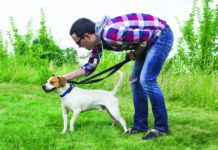People often fear getting bitten by a big dog, but even a Chihuahua is estimated to have a bite force of up to 180 pounds per square inch. To put that in perspective, people have an average bite force of 126 pounds per square inch.
It’s in part for that reason that the American Veterinary Medical Association (AVMA) says that “any dog can bite: big or small, male or female, young or old. Even the cuddliest, fuzziest, sweetest pet can bite if provoked. Remember,” the AVMA says, “it is not a dog’s breed that determines whether it will bite, but rather the dog’s individual history and behavior.”
 It’s a serious issue. More than 4.5 million people are bitten by dogs in this country each year, with more than 800,000 of them requiring medical attention. Anyone can end up bitten in the wrong situation, although children are the most likely to be affected — most often by dogs that are familiar to them rather than by dogs that they don’t know.
It’s a serious issue. More than 4.5 million people are bitten by dogs in this country each year, with more than 800,000 of them requiring medical attention. Anyone can end up bitten in the wrong situation, although children are the most likely to be affected — most often by dogs that are familiar to them rather than by dogs that they don’t know.
Dogs bite for a variety of reasons, but not because they are trying to show who’s boss.
Dog bites are preventable
Fortunately, as the AVMA points out, there’s much you can do to keep a dog bite from occurring.
Socialize your dog. By introducing your dog to people and other animals while it is still a puppy, you can help him to feel relaxed in different situations. If your dog is a rescue who came into your life as an adult, you can socialize him very gradually if he needs that kind of paced acclimation. And keep him on a leash in public to give you control in a situation your pet might perceive as fraught.
Be responsible about your pet. Not only should you select the dog that’s right for your family (so your young children and anyone else in the home will remain safe), but you should also 1) regularly train him, 2) provide opportunities for regular exercise, and 3) neuter or spay the animal if you don’t plan on breeding it. Training such as “Sit,” “Stay,” “Come” is critical, and not just so your dog will listen to you. It increases the bond between the two of you and will make him more likely to listen to you in an anxiety-filled situation. Your dog looks to you for direction and desires clear expectations that he can follow through on. Training accomplishes all of that.
The reason exercise is necessary is that it fosters good emotional health as well as physical health. A dog with pent-up energy to spare might very well be more anxious — and more apt to react aggressively in situations when he feels threatened. And neutering your pet often has the effect of cutting way down on any aggressive tendencies.
Educate your family. This is very much about teaching children how — and even whether — to approach a dog. They should be instructed about moving calmly around dogs rather than excitedly.
Avoid risky situations. The advice above is largely for how to make your own dog less likely to bite. You also need to take steps to insure that you are not bitten by other dogs. The ASPCA reminds dog lovers to avoid trying to pet a dog in the following scenarios:
- If the dog is not with its owner.
- If the dog is with its owner but the owner does not give permission to pet the dog.
- If the dog is on the other side of a fence— don’t reach through or over a fence to pet a dog.
- If a dog is sleeping or eating.
- If a dog is sick or injured.
- If a dog is resting with her puppies or seems very protective of her puppies and anxious about your presence.
- If a dog is playing with a toy.
- If a dog is growling or barking.
- If a dog appears to be hiding or seeking time alone.
Some of these recommendations also apply to a dog who lives with you. For instance, it’s safest not to try to pet a dog when he is taking a nap or having a meal. An opportunity to show him affection will come soon enough.





